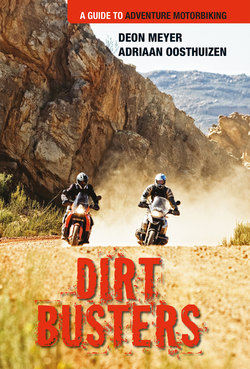Читать книгу Dirt Busters - Деон Мейер - Страница 8
На сайте Литреса книга снята с продажи.
ОглавлениеNaming the book
The hardest part about putting this book together was finding the right title and subtitle for it. It was really tough and not only because it is an off-beat all-in-one attempt at a route guide, photographic record, a bit of iron horse philosophy and a textbook with instructions on how to ride your motorbike. The biggest problem was semantics: what do you call these motorbikes which, like a Swiss army knife, can do just about everything?
Some journalists refer to the big adventure bikes as ‘dual-purpose’ or ‘dual-sports’ models – quite rightly so, of course, as they are equally at home on dirt and on tar. But many of the smaller dirt bikes share this ability, such as the old Yamaha XT500. Yet these bikes are not comfortable long-distance touring bikes.
It’s also a known fact that you don’t need a dual-purpose motorbike if you’re after adventure. Any motorbike tour is an experience, whether it’s on a Vespa, a Honda Fireblade or a Kawasaki KLR 650. For all these reasons ‘dual-purpose motorbikes’ would not have sufficed in our subtitle ‘A Guide to …’
We also considered ‘dirt-road motorbikes’, but we were worried that we might receive indignant letters about false advertising from people who own 450cc (or smaller) dirt bikes. Although many of the fundamental principles are the same, the focus of our effort lies elsewhere.
The search for the right name and subtitle became pretty drawn out – and started to interfere with our touring plans. The purpose of this book is to share our passion for what we believe is the most enjoyable way to ride a motorbike – the why, the where and the how. That was how we came up with ‘A Guide to Adventure Motorbiking’ – quite a mouthful, but it probably sums up what we do the best. BMW and KTM sometimes call their big models Adventure, but this is purely incidental. This book is not aimed solely at owners of these bikes.
So, which kind of bikes are we talking about? Versatile bikes for tar and gravel of 650cc or more. We’re talking about the big dogs, which have been built for long distances with good rider protection, significant capacity for luggage and that can travel at least 250 km on a tank and – should you feel the urge – at 120 km/h or faster, with enough power and room for a passenger. It should be able to do this all day long, for seven days a week.
We want to share our favourite routes and a few stories about them. We also explain different riding techniques. This book will teach you that it is easy (and fun) to master any surface (if you focus a little and spend enough time in the saddle).
We explain the theory behind the skills, and show you how to apply it in practice.
This guide will also help you to buy a touring bike – whether new or second hand – that best suits your needs, budget and ability, as well as the right accessories. And there’s advice on how to adjust your bike for easier and safe riding.
An oft-repeated refrain at Jan du Toit’s Country Trax Off-Road Riding Academy in Amersfoort is: ‘There’s too much to remember. Do you have any printed material that covers all these interesting principles?’
We aim to provide just that in this book.
And then there are Adriaan Oosthuizen’s amazing photographs to illustrate the beauty and atmosphere of this lifestyle.
But, there are also a few things this book is not … It is not a correspondence course for dirt and off-road bikes. That is why the subtitle describes it as a guide. It is nothing more or nothing less than that. Dirt Busters won’t turn you into the Big Gravel Guru overnight, no matter how many times you read it. What it should do is increase your understanding of what it takes to control a big dual-purpose bike on the dirt.
A good course offers more depth of theory than our book (some principles simply cannot be explained effectively on paper) and of course the value of practice is priceless. So we strongly urge you to complete an official, accredited off-road course after you read this book. And then spend enough time in the saddle. There is nothing like practice to hone your skills – and make them become second nature.
Or do the course first, and then read the book. But do the course. Please. Even better, do the course two or three or four times. And read the book again. Keep riding, learning and reading. Because, as Jan always says: ‘Repetition is the mother of skill.’
